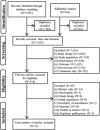Surveillance in Patients With Barrett's Esophagus for Early Detection of Esophageal Adenocarcinoma: A Systematic Review and Meta-Analysis
- PMID: 26658838
- PMCID: PMC4816094
- DOI: 10.1038/ctg.2015.58
Surveillance in Patients With Barrett's Esophagus for Early Detection of Esophageal Adenocarcinoma: A Systematic Review and Meta-Analysis
Abstract
Objectives: Although endoscopic surveillance of patients with Barrett's esophagus (BE) has been widely implemented for early detection of esophageal adenocarcinoma (EAC), its justification has been debated. This systematic review aimed to evaluate benefits, safety, and cost effectiveness of surveillance for patients with BE.
Methods: MEDLINE, EMBASE, EconLit, Scopus, Cochrane, and CINAHL were searched for published human studies that examined screening practices, benefits, safety, and cost effectiveness of surveillance among patients with BE. Reviewers independently reviewed eligible full-text study articles and conducted data extraction and quality assessment, with disagreements resolved by consensus. Random effects meta-analyses were performed to assess the incidence of EAC, EAC/high-grade dysplasia (HGD), and annual stage-specific transition probabilities detected among BE patients under surveillance, and relative risk of mortality among EAC patients detected during surveillance compared with those not under surveillance.
Results: A total of 51 studies with 11,028 subjects were eligible; the majority were of high quality based on the Newcastle-Ottawa quality scale. Among BE patients undergoing endoscopic surveillance, pooled EAC incidence per 1,000 person-years of surveillance follow-up was 5.5 (95% confidence interval (CI): 4.2-6.8) and pooled EAC/HGD incidence was 7.7 (95% CI: 5.7-9.7). Pooled relative mortality risk among surveillance-detected EAC patients compared with nonsurveillance-detected EAC patients was 0.386 (95% CI: 0.242-0.617). Pooled annual stage-specific transition probabilities from nondysplastic BE to low-grade dysplasia, high-grade dysplasia, and EAC were 0.019, 0.003, and 0.004, respectively. There was, however, insufficient scientific evidence on safety and cost effectiveness of surveillance for BE patients.
Conclusions: Our findings confirmed a low incidence rate of EAC among BE patients undergoing surveillance and a reduction in mortality by 61% among those who received regular surveillance and developed EAC. Because of knowledge gaps, it is important to assess safety of surveillance and health-care resource use and costs to supplement existing evidence and inform a future policy decision for surveillance programs.
Figures







References
-
- Wang KK, Sampliner RE. Updated guidelines 2008 for the diagnosis, surveillance and therapy of Barrett's esophagus. Am J Gastroenterol 2008; 103: 788–797. - PubMed
-
- Phillips WA, Lord RV, Nancarrow DJ et al. Barrett's esophagus. J Gastroenterol Hepatol 2011; 26: 639–648. - PubMed
-
- Fountoulakis A, Zafirellis KD, Dolan K et al. Effect of surveillance of Barrett's oesophagus on the clinical outcome of oesophageal cancer. Br J Surg 2004; 91: 997–1003. - PubMed
LinkOut - more resources
Full Text Sources
Other Literature Sources

